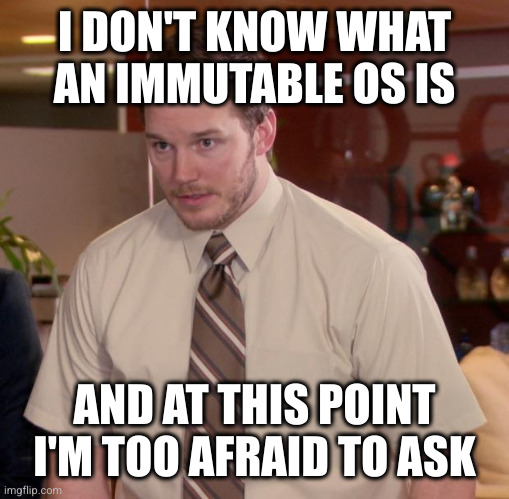this post was submitted on 24 Jul 2024
515 points (97.8% liked)
linuxmemes
21304 readers
1087 users here now
Hint: :q!
Sister communities:
- LemmyMemes: Memes
- LemmyShitpost: Anything and everything goes.
- RISA: Star Trek memes and shitposts
Community rules (click to expand)
1. Follow the site-wide rules
- Instance-wide TOS: https://legal.lemmy.world/tos/
- Lemmy code of conduct: https://join-lemmy.org/docs/code_of_conduct.html
2. Be civil
- Understand the difference between a joke and an insult.
- Do not harrass or attack members of the community for any reason.
- Leave remarks of "peasantry" to the PCMR community. If you dislike an OS/service/application, attack the thing you dislike, not the individuals who use it. Some people may not have a choice.
- Bigotry will not be tolerated.
- These rules are somewhat loosened when the subject is a public figure. Still, do not attack their person or incite harrassment.
3. Post Linux-related content
- Including Unix and BSD.
- Non-Linux content is acceptable as long as it makes a reference to Linux. For example, the poorly made mockery of
sudoin Windows. - No porn. Even if you watch it on a Linux machine.
4. No recent reposts
- Everybody uses Arch btw, can't quit Vim, and wants to interject for a moment. You can stop now.
Please report posts and comments that break these rules!
Important: never execute code or follow advice that you don't understand or can't verify, especially here. The word of the day is credibility. This is a meme community -- even the most helpful comments might just be shitposts that can damage your system. Be aware, be smart, don't fork-bomb your computer.
founded 1 year ago
MODERATORS
you are viewing a single comment's thread
view the rest of the comments
view the rest of the comments

An immutable OS is fixed and mounted non-writable. Every update you get, every program you install is handled on top of it via containers or filesystem overlays so the underlying OS is untouched. Basically the same concept you know from smartphones or other devices with a "reset to factory settings" function. No matter how hard you screw up your system, you can always reset to the base OS, either by granulary deactivating things installed on top, or by a reset to the working base OS.
So how are OS updates handled, they are not written into the main OS?
They are written but don't replace something in the read-only OS. They are just overlayed, so once removed the original is still there. How they do it differs. There are actual overlay filesystems for the job, or some use btrfs where all subvolumes behave mostly like virtual partitions (and copies of a subvolume only take space for changes of the original).
That's interesting. Thanks.